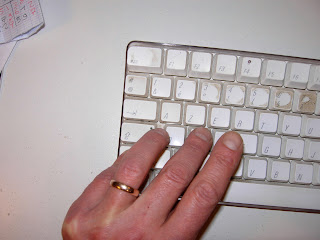 |
| Left index finger goes on F. |
First, you see typos as soon as you make them, and are able to correct them more efficiently, without having to stop typing and going through the typed text again. Second, and more exciting, you will soon notice that when you touch-type you can think as you write. After a while you also discover that you can type-write or type-retype much faster. Then, you can also perform many computer operations through keyboard shortcuts – save, select, copy-paste, etc., also without looking down.
зфпуы - рщц ещ ьфлу сщщгкув щк сщдщгк сщвув увпуы шт ф ьфпфяштуб икщсргку щк ищщл -
The text above was supposed to be in English, I just forgot to switch language mode from Russian to English – and carried on typing while looking at the keyboard and not at the screen. What a nuisance and a punishment for not concentrating. And not remembering to stick to touch-type. When you've mastered touch-typing, you can type without looking at the keyboard, your fingers find the necessary keys all on their own. Much like you tie your shoelaces or press on pedals in the car without looking down.
Why is it important to learn touch-typing (blind typing)?
With so much around us operated through keyboards, it may be considered a basic life skill. At first you may find that touch-typing slows you down, but the more you practice the more you find it liberating to see the text as it appears on screen.
Here is how to start. First, learn the 'home' position of your hands. F and J keys on a QWERTY layout usually have little knobs studs – that's where your left and right index fingers should rest in the basic position. Move left finger to the right to type G and right finger to the left to type H. On QWERTY put the little finger of your left hand on A and the little finger of your right hand on ;. Thumbs should rest on the Space Bar. If a word finishes with a letter in the left-hand segment of the keyboard, hit space with your right thumb, if it's on the right, use your left thumb.
From here learn where all other keys are, relative to the basic position. Start with the basic position and progress to all-fingers touch-typing.
The rest is practice.
There are numerous courses and resources on the web to learn touch typing. Have a look at this BBC animated site, designed primarily for youngsters, but content-wise good for anyone.

Very true. Practice is key. I'm the co-creator of Burning Cargo (http://www.burningcargo.com), an online typing adventure aiming to make practicing less boring. It's quite unique, check it out.
ReplyDeleteThanks for this, I had a look, good resource.
ReplyDelete